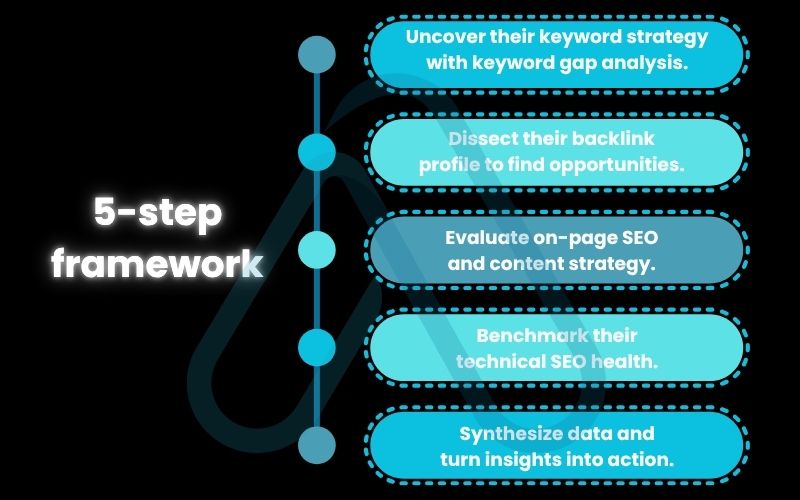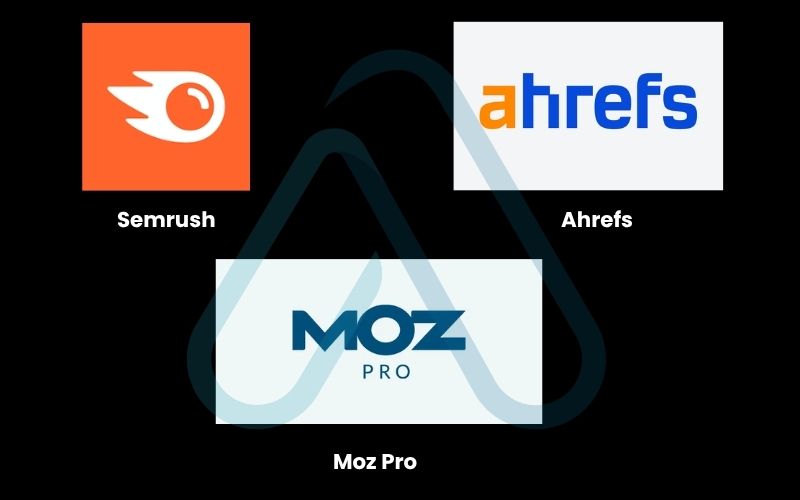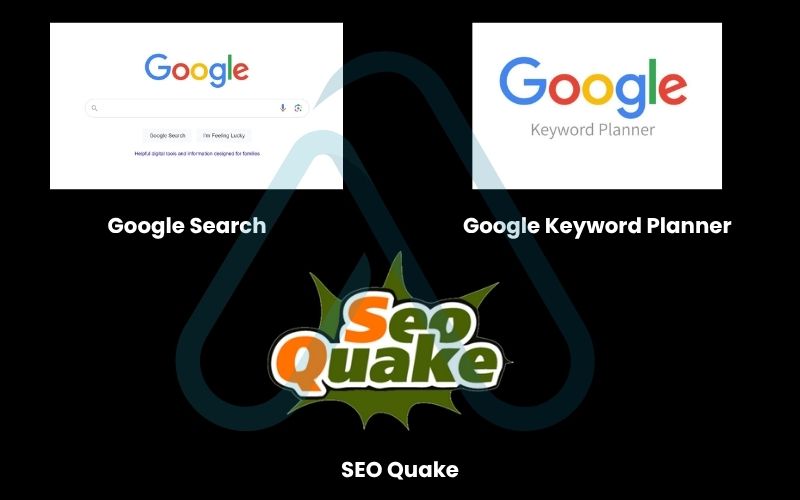If you’re looking for a clear roadmap on how to do a competitor analysis for SEO, you’re in the right place. But I’m going to take you beyond a simple checklist. Over my 10 years in this field, I’ve seen countless people pull data on competitors, only to let it sit in a spreadsheet, unused. The goal isn’t just to see what others are doing; it’s to find actionable intelligence that fuels a smarter, more effective SEO strategy.
This guide offers a holistic approach, combining deep technical analysis with strategic marketing, powerful AI-powered insights, and a firm commitment to ethical practices. You’ll learn how to identify your true search competitors, dissect their strategies, and, most importantly, turn that information into a plan that helps you rank higher. Forget spying; it’s time to start strategizing.
Effective SEO isn’t about mimicking competitors; it’s about understanding the competitive landscape so you can build a superior strategy that wins in the long run.
1. What is SEO competitor analysis (and why it’s not just spying)?
At its core, SEO competitor analysis is the process of researching the content, keywords, backlinks, and technical performance of the websites that appear in search results for your target keywords. I prefer to frame this not as spying but as gathering strategic intelligence. It’s a foundational part of any digital marketing strategy, providing the context you need to make informed decisions. This process involves looking at both direct and indirect competitors to get a full picture of the search landscape.
| Competitor Type | Description & Example |
|---|---|
| Direct Competitors | These are businesses offering a similar product or service. If you sell running shoes online, other online running shoe stores are your direct competitors. You compete for the same customers and keywords like best trail running shoes. |
| Indirect Competitors | These entities compete for your audience’s attention and your keywords, but don’t sell the same product. For a running shoe store, a major running blog or a health magazine reviewing shoes are indirect competitors. They rank for your keywords but serve a different primary purpose. |
A crucial point I always stress is that your real-world business competitor might not be your primary SEO competitor. A local bakery competes with other bakeries in town, but on Google, it might be competing with a national recipe blog for the keyword best chocolate chip cookie recipe.
Here’s how I find the real players.
- Brainstorm seed keywords: Start with a list of 5-10 core topics or keywords you believe your customers use to find you. These are your starting points.
- Use an SEO tool: Enter these seed keywords into a tool like Semrush or Ahrefs. These platforms will show you the top-ranking domains for those terms. The websites that consistently appear are your true SEO competitors.
- Analyze the SERPs manually: For your most important keywords, perform a Google search and see who shows up on page one. The patterns you see will be very revealing.
- Shortlist for focus: From your research, identify the top 3-5 competitors. Analyzing hundreds is a waste of time. A focused SEO competitor analysis on a few key players will yield more actionable insights.
2. How to do a competitor analysis for SEO (5-step framework)
To effectively learn how to do a competitor analysis for SEO, you need a structured approach. I’ve refined my process over the years into a 5-step framework that ensures no stone is left unturned and that the data gathered leads directly to strategic actions.
Step 1: Uncover their keyword strategy with keyword gap analysis.
Step 2: Dissect their backlink profile to find opportunities.
Step 3: Evaluate on-page SEO and content strategy.
Step 4: Benchmark their technical SEO health.
Step 5: Synthesize data and turn insights into action.

2.1. Step 1: Uncover their keyword strategy with keyword gap analysis
This is my starting point for almost every analysis because it provides the most immediate value. A keyword gap analysis shows you the keywords your competitors rank for that you don’t. It’s a goldmine for content ideas and strategic pivots. Using a tool like Semrush’s Keyword Gap, you can enter your domain and up to four competitor domains.
The tool then generates lists of keywords, which I typically categorize into three buckets. The key is not just to find the keywords, but to ask ‘so what?’. Prioritize the keywords based on their relevance to your business, search volume, and your ability to create content that is genuinely better than what your competitor has published. This analysis forms the foundation of your future content plan.
2.2. Step 2: Dissect their backlink profile to find opportunities
A backlink analysis is critical for understanding a competitor’s authority and ranking power. Backlinks are like votes of confidence from other sites, and Google pays close attention to them. When I conduct a backlink analysis, I’m not just looking at the total number of links; I’m investigating their link-building strategy.
Are they getting links from guest posts on industry blogs? Are they featured in news articles? Do they have a resource that gets cited by universities? Stress the goal is not to copy every link, but to understand their link-building strategy. Here are the key metrics I focus on.
- Domain Authority/Rating: A score (typically out of 100) that predicts a site’s ranking potential.
- Referring Domains: The number of unique websites linking to them. This is often more important than the total number of backlinks.
- Link Velocity: The speed at which they are acquiring new backlinks. A sudden spike might indicate a successful digital PR campaign.
- Link Types: The context of the links (e.g., editorial, resource pages, guest posts). This reveals their strategy.
2.3. Step 3: Evaluate on-page SEO and content strategy
Now that you know what your competitors are ranking for, it’s time to understand how they’re doing it on the page level. This step involves a manual review of their top-performing pages. I use a checklist to ensure my analysis is consistent and thorough, looking for patterns in how they apply SEO best practices.
This process helps identify content gaps – where they’ve covered a topic weakly – and content format opportunities, such as creating a video or calculator where they only have text. The following is a simplified checklist I use for this process.
- Title Tag & H1: Is the primary keyword present and compelling?
- Heading Structure: Do their H2s and H3s logically cover the topic and target related sub-topics?
- Content Format: Are they using lists, images, videos, or interactive elements? Is the content a guide, a review, or a listicle?
- Content Quality: Is the information accurate, up-to-date, and comprehensive? Where are the gaps I can fill?
- Internal Linking: How are they linking to other relevant pages on their site to build topic authority and guide users?
2.4. Step 4: Benchmark their technical SEO health
Technical SEO can feel intimidating, but it’s often a source of competitive advantage. A technically sound site is faster, easier for Google to crawl, and provides a better user experience. While I don’t perform a full technical audit on a competitor, I do a quick benchmark to spot major weaknesses or strengths. Using free tools like Google’s PageSpeed Insights or the Lighthouse report in Chrome DevTools, you can get a high-level view of key metrics.
Even small technical advantages, like a site that loads one second faster, can have a significant impact on rankings and user engagement over time. A solid SEO strategy must be built on a healthy technical foundation, and checking your competitors shows you the standard you need to meet or exceed. I primarily look at their Core Web Vitals, mobile-friendliness, and use of schema markup.
2.5. Step 5: Synthesize data and turn insights into action
This is the most critical step. Data without action is useless. Here, you bring all your findings from the previous steps together to form a cohesive strategy. I find that a simple SWOT (Strengths, Weaknesses, Opportunities, Threats) analysis is an effective way to organize the data. This framework forces you to move from raw data to strategic insights, directly bridging the gap between analysis and execution.
For example, a competitor’s weakness in site speed becomes your opportunity to create a better user experience. Their strength in earning backlinks from guest posts reveals an opportunity for you to develop a similar outreach program. This final step is how you can improve your SEO rankings by analyzing competitors – by turning competitor research into a tangible part of your digital marketing strategy.
| SWOT Element | Example SEO Insight |
|---|---|
| Strength | Competitor A ranks #1 for ‘keyword x’ with a comprehensive 3,000-word guide. |
| Weakness | Competitor B’s top pages have poor Core Web Vitals scores and load slowly. |
| Opportunity | No top competitors have video content for ‘keyword y’. This is a content format gap. |
| Threat | Competitor C is acquiring high-authority backlinks at a very fast rate. |
3. A comprehensive list of SEO tools for competitor analysis
While strategy is paramount, the right tools make the data gathering process for an SEO competitor analysis infinitely more efficient. The best tool for you depends on your budget and specific needs, so I’ve broken down some of the top options I personally use and recommend.
3.1. All-in-one platforms (paid)
These platforms are the powerhouses of SEO data, offering a suite of tools that cover everything from keywords to technical audits.
Semrush
An incredibly versatile platform that I find particularly strong for keyword research and content marketing features.
- Best for: Keyword gap analysis, topic research, and analyzing a competitor’s paid search strategy.
Ahrefs
Widely regarded as having the best backlink index on the market. If link building is a primary focus, this is a must-have tool.
- Best for: Deep backlink analysis, tracking new and lost referring domains, and identifying top-linked content.
Moz Pro
A great all-around tool with a very user-friendly interface, making it an excellent choice for those newer to SEO.
- Best for: Link building opportunities with its Link Explorer and tracking local search rankings with Moz Local.

3.2. Powerful and free tools
You don’t need a massive budget to get started. These free tools provide a wealth of information if you’re willing to put in a bit more manual work.
| Tool Name | Primary Use Case | Limitation to Note |
|---|---|---|
| Google Search | Manually analyzing SERPs, titles, meta descriptions, and ‘People Also Ask’ sections. | Highly manual and time-consuming for large-scale analysis. |
| Google Keyword Planner | Finding seed keywords and getting rough search volume estimates. | Requires a Google Ads account; volume data is often bucketed into wide ranges. |
| SEO Quake | A browser extension that provides a quick on-page SEO summary for any page you visit. | Data is high-level and not as in-depth as paid platforms. |

4. Building your AI-powered competitor analysis pipeline
This is where we move into the next level of competitor analysis. Integrating Artificial Intelligence (AI) tools like ChatGPT or Claude into your workflow can dramatically accelerate your research and uncover deeper insights that manual analysis might miss. I’ve found this to be a game-changer for my own efficiency and strategic depth.
4.1. Using AI to summarize competitor content themes
Manually reading the top 10 articles for a target keyword can take hours. With AI, you can do it in minutes. By feeding the content (or just the URLs) of top-ranking pages into an AI model, you can ask it to summarize the main themes, key arguments, and unique angles each competitor takes. This is the difference between spending two hours reading and five minutes getting a synthesized report. This process helps you spot content gaps and opportunities with incredible speed. Here’s a prompt I often use:
Prompt: I’m writing an article on [topic]. Here are the URLs of the top 5 ranking articles. Please analyze their content and provide a summary of the main themes, common subtopics covered, and any unique angles or data each article presents. Finally, suggest 3-5 content gaps or opportunities for me to create a superior article.
4.2. Leveraging AI for SERP and sentiment analysis
AI can also help you understand the intent and emotion of a search engine results page. You can copy and paste the titles and meta descriptions of the top 10 results and ask an AI to analyze them. It can categorize the results (e.g., how-to guides, listicles, reviews), identify emotional trigger words used in headlines, and summarize the overall sentiment of the SERP.
This sophisticated analysis helps you craft titles and descriptions that better resonate with what searchers are looking for, giving you a competitive edge in click-through rates. The benefits of this approach are significant.
- Faster and more nuanced SERP intent analysis.
- Identification of emotional triggers and persuasive language in titles.
- A deeper understanding of what resonates with users for a specific query.
5. The ethical guide to competitor research
As a professional, it’s my responsibility to emphasize the importance of ethics. Our goal is to gather public intelligence to build a better strategy, not to engage in malicious or illegal activities. Building trust with your audience starts with running your business responsibly. The line between ethical analysis and unethical practices is very clear.
We analyze publicly available data; we do not attempt to access private information. Here’s a simple guide to keep you on the right side of that line.
PROS
- Analyze public backlink profiles using tools like Ahrefs.
- Review their public content and on-page SEO elements.
- Sign up for their public newsletter to understand their marketing.
- Analyze SERP data and public keyword rankings.
CONS
- Attempt to access their private Google Analytics account.
- Use software to scrape their entire website excessively, potentially causing server issues.
- Engage in negative SEO by building spammy links to their site.
- Use hacking, phishing, or social engineering to gain private information.
6. FAQs about competitor analysis for SEO
How often should I conduct an SEO competitor analysis?
Conduct a deep-dive SEO competitor analysis quarterly to stay updated on strategy shifts. Additionally, perform lighter monthly check-ins on your top 3 competitors to track changes in keyword rankings and backlinks. Also, analyze whenever there’s a major Google algorithm update or a new competitor enters your market.
What is the most important part of a competitor analysis?
The most important part of a competitor analysis is turning insights into action (Step 5). While keyword gap analysis offers immediate, actionable insights for your content strategy, the real value lies in implementing changes to improve your own SEO strategy.
Can I do a competitor analysis without paid tools?
Yes, you can conduct a competitor analysis without paid tools, though it will take more time. Use free resources like Google Search and Keyword Planner for manual research on SERPs. You can also review competitors’ sites by checking their page source for title tags and meta descriptions. While more effort is needed, valuable insights can still be gained without a budget.
Glossary of key terms
| Abbreviation | Full Term | Meaning |
|---|---|---|
| SEO | Search Engine Optimization | The practice of increasing the quantity and quality of traffic to your website through organic search engine results. |
| SERP | Search Engine Results Page | The page displayed by a search engine in response to a query by a searcher. |
| LSI | Latent Semantic Indexing | A concept search engines use to discover the relationship between terms and concepts in content. LSI keywords are terms related to a main keyword. |
| SWOT | Strengths, Weaknesses, Opportunities, Threats | A strategic planning technique used to help an organization identify key factors for decision-making. |
| AI | Artificial Intelligence | The simulation of human intelligence in machines, particularly computer systems, used here to analyze data and text. |
| CTA | Call to Action | A prompt on a website that tells the user to take some specified action. |
7. Final thoughts
An effective SEO competitor analysis is a continuous process, not a one-time project. It’s about developing a system for gathering intelligence and, more importantly, integrating that intelligence into your SEO strategy. By moving from a mindset of spying to one of strategic analysis, you empower yourself to make smarter, data-driven decisions that lead to sustainable growth.
You now have the framework to not just analyze, but to out-strategize your competition.
- Strategy Over Tactics: The goal is not to copy competitors, but to understand the landscape to build a superior plan.
- Action is Everything: Data is only valuable when it is translated into concrete actions and improvements.
- AI is a Force Multiplier: Leveraging AI can save you hours of manual work and uncover deeper insights, giving you a significant competitive advantage.
- Ethics are Non-Negotiable: Always conduct your research in a responsible and ethical manner to build long-term trust and authority.
Now that you have this strategic framework, it’s time to put it to use. For more in-depth guides to elevate your digital presence, explore our Digital Marketing Strategies categories on Afdevinfo.


